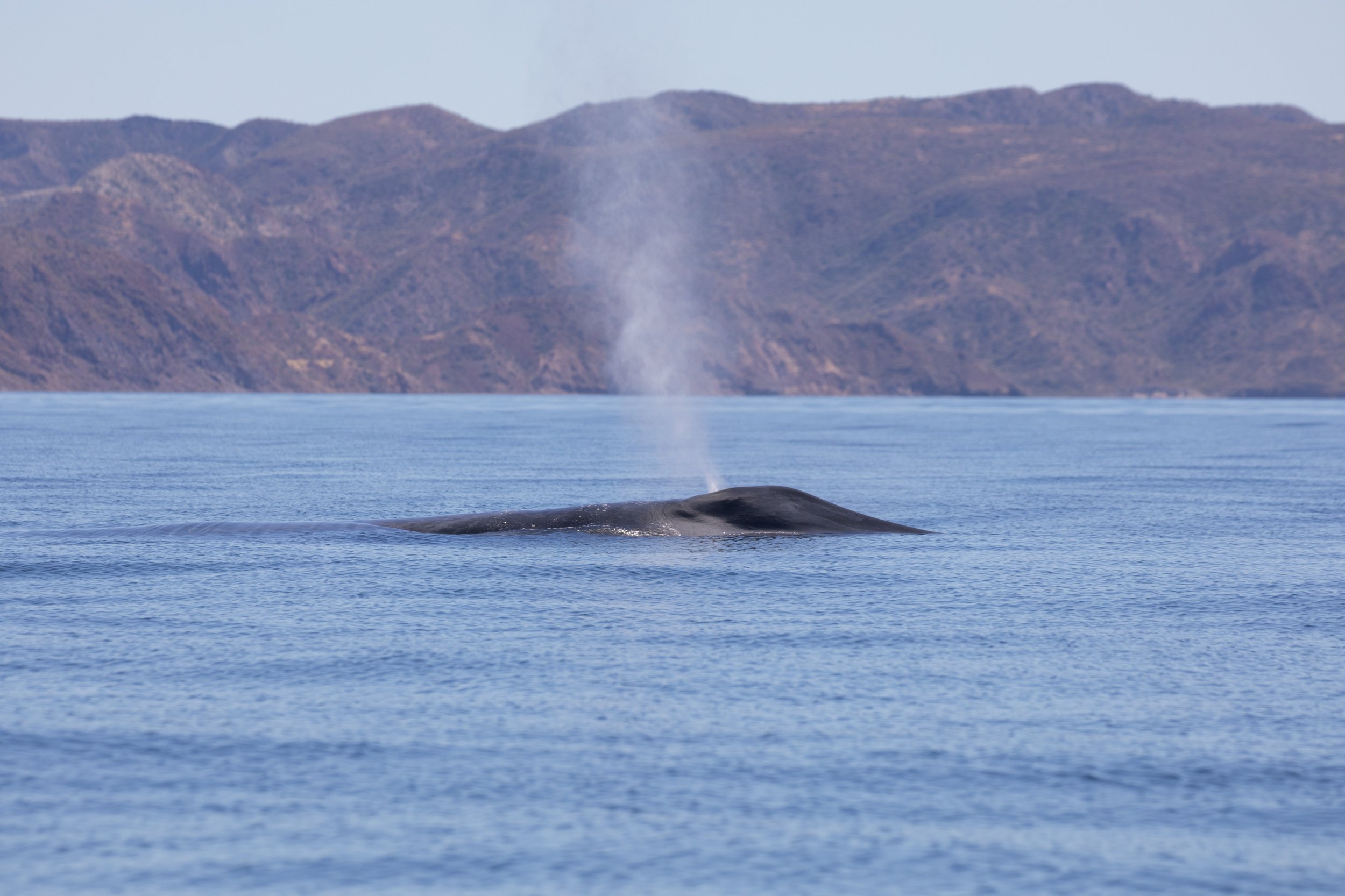Our calendar is now open for the next blue whale season in Loreto:
Blue whale fluke in Loreto National Park captured by our wildlife guide and expedition leader Regina Domingo
Discover the magnificence of these species and how our team is preparing to welcome them!
Ecology and status of blue whales
The blue whale (Balaenoptera musculus) is the largest mammal on Earth and plays a crucial role in marine ecosystems. As members of the Balaenopteridae family, blue whales have distinctive grooves known as gular pleats that expand when feeding, allowing them to filter-feed on small crustaceans called euphausiids (krill).
Physical characteristics
Blue whales have a wide, U-shaped head with high ridges around their blowholes. They can grow up to 33.6 meters long and weigh as much as 190 tons. Their dorsal fin is small, while their tail fluke is broad.
Reproductive biology
Blue whales typically give birth every 2-3 years after a gestation period of 10-12 months. At birth, calves are about 7 meters long and are weaned around 6-8 months later. They reach sexual maturity between 5 and 10 years and can live up to 90 years.
Blue whale fluke in Loreto National Park captured by our wildlife guide and expedition leader Regina Domingo
Distribution and social structure
Blue whales are found in the Gulf of California and along the Baja California Peninsula, where they gather in areas rich in krill. The population in the Northeast Pacific is estimated at 2,000 to 3,000 individuals. Socially, they are mostly solitary or found in very small groups, with some individuals accompanying mothers with calves.
Conservation status
Classified as endangered species by the IUCN Red List, blue whale populations are estimated to be between 10,000 and 25,000—significantly lower than pre-whaling estimated of up to 250,000. Key threats include noise pollution, ship strikes, climate change, and environmental contaminants. Despite some recovery since whaling bans were implemented, ongoing conservation efforts are essential to protect these magnificent creatures.
Get Ready for our blue whale season 2025 in Loreto
As we prepare for an incredible season we’re excited to share what awaits you. Our expeditions are led by two experienced guides and a skilled local captain who will take you through stunning areas in the Loreto National Marine park where blue whales come to feed, rest, nurse, and socialize.
The Journey of the blue whales
Every winter and spring, blue whales migrate to the Gulf of California seeking nutrient-rich waters filled with krill. Generally, a blue whale will stay in Loreto National Park for about 70 days. Last season, our first encounters were on December 22nd, with the last sightings around the second week of March. According to official season dates released by Mexico's Diario Oficial de la Federación, blue whale season runs from January 1st to April 30th. In the Gulf of California, blue whales congregate in areas rich in biomass where Nyctiphanes simplex, a type of krill, thrives. Female blue whales often prefer coastal zones to nurse their calves, making this region vital for their survival.
Blue whale blow in Loreto National Park captured by our wildlife guide and expedition leader Regina Domingo
Our expedition options
We offer two types of expeditions:
Daily Expeditions: Our daily expeditions depart from Loreto Marina at sunrise or midday until sunset (weather permitting) with a maximum of 8 participants for an intimate experience lasting 7 to 8 hours. During this time, our two guides will share insights about Loreto National Park and the marine mammals we encounter; we might see not only blue whales but also other large whales like humpbacks and fin whales and our beloved local dolphins. This expedition includes a light breakfast, healthy snacks, lunch, and high-quality photos from your adventure. Given our popularity during the season, we recommend booking in advance. Private expeditions for small groups or couples are also available.
Multi-Day Itineraries:
Baja Whale Expedition: Over five days and four nights, experience three marine expeditions focusing on blue whales and other winter visitors like fin whales, hybrid whales, humpbacks whales, dolphins, and occasionally orcas—an ecotype known for their expertise in feeding on baleen whales. This itinerary includes a Pacific lagoon expedition to meet gray whales—the marine species that makes the longest migration of any mammal on Earth. Your accommodations will be in downtown Loreto near the colonial center in the heart of this beautiful Mexican oasis.
Whales and Oases Expedition: This four-day, three-night adventure includes two marine expeditions to encounter various whale species, including blue whales, fin whales, humpback whales, and gray whales—one expedition in Loreto and another in a Pacific lagoon. Participants will also enjoy 2 land expeditions, one hike through Loreto Canyon to explore nutrient sources and one biocultural expedition visiting San Javier Mission to learn about the peninsula's rich history and culture. Additionally, we will ride mules through the Sierra de la Giganta, arriving at a beautiful remote oasis.
Our Team
Our dedicated team consists of knowledgeable guides passionate about wildlife, culture, and history. They will share insights about species behaviors and the unique ecosystems of Baja California.
Blue whale blow in Loreto National Park captured by our wildlife guide and expedition leader Regina Domingo
What to Expect on our Expeditions
Exploration of key areas: We’ll navigate prime feeding grounds and socializing spots for blue whales.
Comfortable vessels: Our boat in Loreto, La Puma, is designed for exploration, comfort and safety.
Our team is getting ready with new gear for the season:
New binoculars: For our monitoring efforts and for guests to see every detail of each species we encounter.
Telephoto Lenses: for species photo identification
Comfort accessories: Mexican soft blankets to stay warm.
Safety equipment: Permits for non-extractive operations to conduct whale watching in Loreto; our boat is equipped with new life jackets, radios, a satellite phone, and an updated emergency kit. Plus, our team is receiving training on first emergency response courses led by Cruz Roja and EMZAG BC—a multidisciplinary team that trains paramedics for remote areas.
Preparing for your Adventure
We’re committed to ensuring every detail is taken care of for a seamless experience. Our team is busy stocking up on essential gear and fine-tuning our itineraries based on whale migration patterns.
Book your spot!
Our calendar is now open for bookings! While most spaces for February are already reserved, we still have available dates in January, March, and early April, also fantastic months to encounter these magnificent creatures. Don’t miss out, reserve your spot today and get ready for an unforgettable journey in Loreto!




